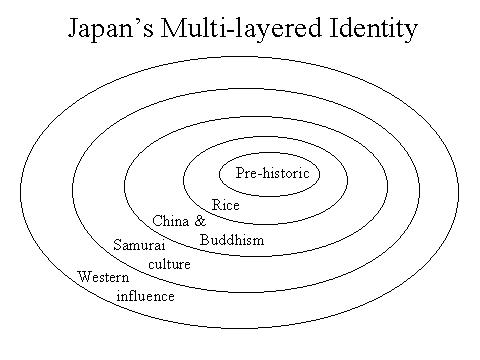
(See Handout no.1)
In any country, history proceeds as an interaction between domestic and foreign forces. In the discussion of Japanese development to follow, this aspect of systemic interaction will be emphasized. Japan's modernization began with the encounter with the powerful West in the 19th century. The path of Japanese industrialization thereafter can be interpreted as the process of various domestic actors, including the government, businesses, communities and individuals, responding to shocks and influences coming from abroad. This perspective is very useful even today, since developing countries are now required to develop under the strong presence of globalizing pressure. The development process of your country can also be understood as two systems, local and foreign, in dynamic interaction. Today, new ideas and systems often come with the names like the market mechanism, democracy, conditionality, international best practice, Good Governance, MDGs, and so on. External systems are usually more powerful than local ones.
The domestic society is the base into which new foreign systems are introduced. Each society has unique characteristics reflecting its ecology and history. Existing institutions in any society are mutually dependent and form a coherent whole (this is called "institutional complementarity"). The domestic society has its own logic and mechanism of internal evolution and, for certain periods, it can evolve mainly through internal forces. This evolution is usually slow and continuous. But when exposed to strong foreign impact, social equilibrium is suddenly disturbed and the country is dislodged from its previous course. If the domestic response to foreign forces is resilient and appropriate, the society will begin a new dynamic evolution. But if the response is weak or inconsistent, the society may be destabilized or even destroyed under foreign dominance.
The term development does not necessarily imply the existence of external influence. Theoretically, development can be internally driven or externally motivated. In our age, however, it has become almost impossible to achieve sound and sustainable development without effectively coping with and integrating into the global economic system. Development now carries almost the same meaning as "catching up with industrial countries" or "modernization through trade, FDI, and industrialization." From a long historical viewpoint, this is a very special type of development. But we can hardly think of any other way. Whether desirable or not, this is the reality we face today.
In the 20th century, isolation and self-sufficiency were pursued under socialist planning, but the effort failed brilliantly to produce economic dynamism. Since the disappearance of the Soviet Union, refusal to integrate into the world has been totally discredited as a national economic strategy. Now the question is not whether to integrate, but how to integrate successfully. International integration is the necessary condition for development, but it is not sufficient.
Throughout its history, Japan also experienced periods of relatively tranquil internal evolution and periods of dynamic changes under strong external influences. These periods alternated to create the Japanese society in a multi-layered fashion. The major external impacts on Japan included the following:
--Rice cultivation: introduced from the Asian Continent around the third century BC (recent evidence shows that rice cultivation may have been brought to Japan earlier)
--Buddhism: from China via Korea, sixth century AD
--Chinese culture and political system: from the seventh to the early tenth century AD
--First direct contact with Europeans: 16th century AD (arrival of guns and Christianity)
--Modernization: contact with the industrialized West, 19th century
The Mongolians also tried to invade Japan twice in the 13th century, but their military attempts failed. It is said that huge storms destroyed their fleet both times. If the Mongolian invasion was successful, Japan would have received another big foreign impact.
Compared with the history of other countries in the non-Western world, it can be said that Japan absorbed successive external shocks rather well, and used them positively for change and new growth. Japan also retained its national identity throughout this process, although Japan today and Japan in the past are entirely different in their appearance. The Japanese society exhibits a multi-layered onion-like structure where old and new elements coexist flexibly and different characteristics can surface depending on the circumstance. Meanwhile, I have heard one Chinese scholar say that China is like a hard stone ball which cannot change unless it is exploded and replaced by another hard ball (called "revolution"), maybe of a different color.
Our course on Economic Development of Japan focuses on Japan's latest great transformation driven by an external shock, namely, the process of Westernization and industrialization under the strong pressure of the West during the 19th and 20th centuries.
Figure 1-1

The idea of "translative adaptation" is proposed by Prof. Keiji Maegawa, an economic anthropologist at Tsukuba University.
When a country in the periphery joins the world system, it may look as if the country (say, Kazakhstan) is being absorbed in the dominant international order (say, the global market system). It looks as if the country is forced to abandon its traditional culture, systems, social structure and so on, which are "backward," and embrace the "international best practice." Viewed from inside the country being absorbed, however, the process is not always passive. In a proper integration process, Maegawa says that the country should take the initiative in deciding the terms of integration, making sure that it can retain "ownership," social continuity and national identity. The country changes, but the change is managed by its government and people (not by foreign firms or organizations). Foreign ideas and systems are introduced not in the original form but with modifications to fit the local needs. If this is achieved, the transformed country is not really so weak or passive. It is taking advantage of external stimuli to change and grow. This is called "translative adaptation." Maegawa says that Japan since the Meiji period did just that. In his own words:
When a non-Western society encounters a powerful representative of Western civilization, it is hardly possible to escape from its influences. Some ethnic groups have been eradicated in short periods after contact with the West. At the same time, many nations and societies have adopted Western institutions and objects from without in order to survive (or by their own choice). However, it is important to recognize that they did not accept Western inventions in their original forms. Any item in one culture will change its meaning when transplanted to another culture, as seen widely in ethnography around the world. Not only cosmology, religious doctrine, rituals, but also the family system, the institution of exchange, and even socio-economic organizations like the firm exhibit the property of adapting to external institutions and principles with the existing cultural system maintaining its form of structure. The essence of what has been called "modernization" is the adaptive acceptance of Western civilization under the persistent form of the existing culture. That is, actors in the existing system have adapted to the new system by reinterpreting each element of Western culture (i.e., "civilization") in their own value structure, modifying yet maintaining the existing institutions. I shall call this "translative adaptation." (Maegawa, 1998, pp.174-175)
Figure 1-2
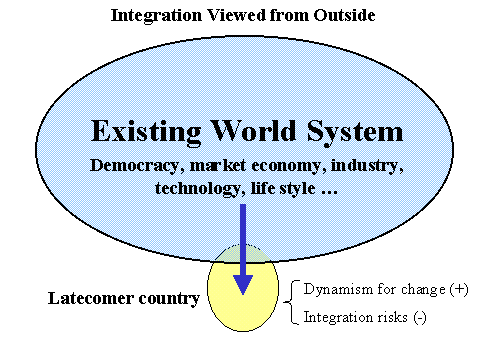
Figure 1-3
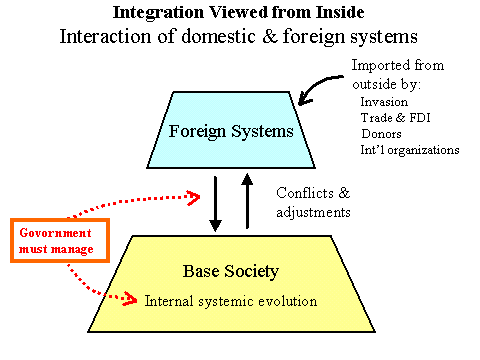
However, international integration is a risky process and not all countries can perform translative adaptation. A developing country exposed to strong external pressure faces a great challenge. This is a dividing moment in the history of that country. Compared with the more predictable days of internal evolution, the fate of the society and its people now depends critically on how they react to this challenge. Domestic capability is still weak while the demands of globalization are high. Suddenly, the country is required to make a great leap forward or fall into an abyss. It is as if an average student is told by his teacher to participate in the international math competition. With enormous effort, he may improve his skill and win. But it is more likely that he will fail miserably. The problem is that the challenge is too big for his current ability. If the goal is unreachable, the effort is not fruitful.
While the effort of domestic businesses and communities is important, the most crucial response to globalization must come from the policies of the central government. If the government loses control of the integration process, dire consequences may occur to the society such as macroeconomic instability, social disintegration, political crisis, ethnic conflict, foreign dominance and so on.
When caught in a dilemma of weak capability and great challenges of globalization, some governments refuse to deal with the external world and revert to isolation, economic control and rejection of Western ideas. Other governments rush to embrace the imported principles of free trade and Western democracy uncritically without considering the effects it brings to the domestic society. Both reaction patterns are shallow, extreme and desperate. Translative adaptation requires much deeper thinking by the top policy makers. It is indeed a very difficult task.
Japan faced great challenges when it opened up to the Western world in the middle of the 19th century. It also experienced a similar hardship after the war defeat of 1945. In both cases, Japan eventually emerged as a brilliantly successful latecomer (at least economically).
Why Japan could do it
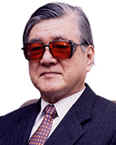 Traditionally, we consider Japan in the 19th century as a weak, agricultural,
backward country with low technology, suddenly exposed to influences from the
powerful West. Japan struggled to industrialize and somehow succeeded. But why
did only Japan succeed so early, among all non-Western countries? This is the
biggest question to whoever studies Japan's modern history. However, Dr. Tadao
Umesao (1920-), distinguished scholar in comparative civilization, says that
there is no mystery here. According to him, Japan emerged as a non-Western
industrial country very naturally.
Traditionally, we consider Japan in the 19th century as a weak, agricultural,
backward country with low technology, suddenly exposed to influences from the
powerful West. Japan struggled to industrialize and somehow succeeded. But why
did only Japan succeed so early, among all non-Western countries? This is the
biggest question to whoever studies Japan's modern history. However, Dr. Tadao
Umesao (1920-), distinguished scholar in comparative civilization, says that
there is no mystery here. According to him, Japan emerged as a non-Western
industrial country very naturally.
For a long time, Dr. Umesao was the general director of the National Museum of Ethnology in Osaka which he founded in 1974. In his earlier days, he traveled extensively in Mongolia, Afghanistan, Southeast Asia, Africa and Europe in anthropological field works. In 1957, he proposed a new theory on the Japanese history and national identity.
Dr. Umesao says that the traditional view of Japan as a backward country is wrong. He argues that Japan and Western Europe are two very unique societies in the world. Both are located on the periphery of the huge Eurasian Continent. Both enjoy temperate climate. More importantly, they are relatively insulated from the violent invasions by nomadic peoples residing in the central dry areas of the Eurasian Continent. He argues that these geographic and climatic advantages are crucial for spontaneous and continuous development of the society. Japan and the United Kingdom are particularly similar in that they are island nations just off the continent.
Japan and Western Europe had the right distance (not too far, not too close) from the great civilizations of Eurasia--China, India, and the Middle East. They could absorb cultural achievements of these civilizations while being invaded and destroyed much less often than societies located in the middle of the continent. This permitted both societies to evolve cumulatively and organically. They mixed domestic culture and foreign impact properly, without being wiped out and having to start over again from scratch. Under these similar historical conditions, Japan and Western Europe developed independently and in parallel. Starting from the unification by an ancient kingdom, their societies decentralized through the rise of local powers, followed by the emergence of the samurai or knight class to protect the land, establishment of feudalism (patronage based on the allocation of the right to rule a region), the rise of local economic powers and systems, and finally capitalism. It is no accident that the Industrial Revolution originated in the UK, and the only non-Western country to industrialize as thoroughly as the West was Japan. In no other areas, history evolves so sequentially.
Figure 1-4
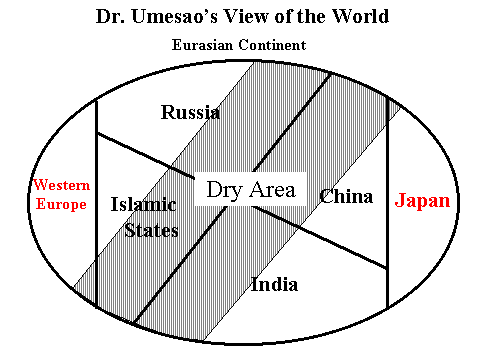
Chinese, Indian and Islamic civilizations produced great cultural achievements, but their social structures were static: only empire and dictatorship (and later, colonialism) ruled. From one dynasty to another, there was no clear progress from the viewpoint of social and political evolution. For thousands of years, emperors and kings were sometimes wise and other times not very wise. Empires and kingdoms differed in their foreign, ethnic and economic policies. But political regimes and socio-economic systems were basically the same.
According to Dr. Umesao, only Western Europe and Japan satisfy the historical conditions necessary to industrialize. Japan did not imitate the West; the two areas developed spontaneously and independently (I suppose North America is regarded as part of Western Europe). He is very pessimistic about the possibility of industrialization in the rest of the world, including all the developing countries today.
I have introduced Dr. Umesao's view to you not because I agree with him completely, but because it is interesting and stimulating. His interpretation of Japanese history is unique and in the minority. Actually, his view is not very well known even among Japanese. Personally, I think the idea that industrialization will take place only under certain fixed historical conditions and nowhere else is too simplistic and deterministic. If the path to industrialization cannot be built but only inherited, ODA, FDI, development economics, World Bank and UNDP policies, and GRIPS programs are all in vain. Can we really say that China will never become an industrialized country? Does Africa have no hope?
I believe industrialization is more dynamic and transferable today. Dr. Umesao's explanation may be valid up to the recent past. However, we are now living in the age of internet, air travel and global exchange of information. Physical distance from the center country should no longer matter very much. Even though history is ingrained deeply in the characteristics of each people, ethnicity is dynamic and changeable. With great leadership and ideas, a new way of development suitable for each country can be found. Moreover, there should be more than one path to development in response to different initial conditions and shifting historical circumstances. Additionally, I think Dr. Umesao makes too little of the role of technology and investment. As a specialist in comparative civilization, he emphasizes the evolution of social structure rather than physical aspects of industrialization.
Having said this, however, Dr. Umesao may be right in certain things. In particular, his theory can explain why Japan before the Western impact had a unique social structure not observable in other countries. This unique social structure was the result of organic and continuous evolution of the Japanese society over two millennia. It permitted Japan to absorb new foreign elements flexibly in a multi-layered fashion and succeed in translative adaptation of Western thought and technology. This, at least partly, should be an answer to the question of why Japan could do it.
The next lecture will show what concrete conditions existed in Japan during the Edo period which led to a rapid catching up in the 19th and 20th centuries.
(Another scholar who argues the parallel development of Japan and Western Europe, especially with respect to the cotton textile industry, is Prof. Heita Kawakatsu of Waseda University.)
The brief history of Japan
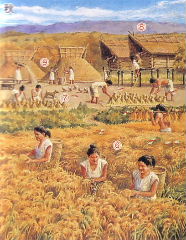 |
|
Rice production began in the Yayoi period (3c BC-3c AD), Communal effort was required. New evidence suggests that rice cultivation may have started earlier. |
In the pre-historic period, the Japanese people (its origin is still debated) were hunter-gatherers with some limited agricultural activity. They lived separately in small villages but were linked by long-distance maritime trade. They lived relatively peacefully.
When rice cultivation was introduced from the continent (third century BC?), life changed significantly. This was because rice cultivation required collective effort beyond families, under effective leadership. Village size grew and social order was established. Religious and military leaders began to form mini states. Wars among mini states became common, and after a few decades of fighting (we still don't know the details of these fights due to the lack of evidence), Japan was politically unified for the first time.
After a few more centuries, the Emperor family took the real power subordinating other influential clans (Taika no Kaishin, or Reform of Taika, 645AD). Under a strong emperor, a centralized government with Chinese-style bureaucratic and tax systems was created. Many capital cities were built and abandoned one after another (consider how much resource was wasted for this !), but finally in 794 the nation's capital was settled permanently in Kyoto (until 1868; Kyoto means capital city). Military conquest of minority peoples was conducted. Buddhism was used for the political purpose of displaying the emperor's power and ruling the country. This is the only period in Japanese history when the emperor had the real political power.
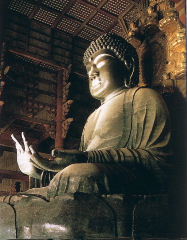 |
|
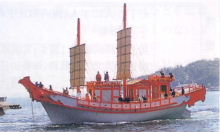 |
|
| A reconstructed mission ship to China. Twenty official missions were sent to China (Tung Dynasty) between 638 and 894, but only 13 reached the destination. Crossing the East China Sea with primitive navigation technique was very dangerous. |
The Great Buddha of Todaiji Temple in Nara, created by the order of Emperor Shomu in 752. It is 15 meters high. A great tourist attraction even today. |
But power concentration did not last very long. Soon, local landlords and temples became more independent from the central government and stopped paying taxes or obeying official orders. They established shoen (manors) and employed people to cultivate them. To protect their land, the warrior class (samurai) emerged. For samurai, land was the most precious thing to be guarded even by risking your life. Meanwhile, the political power of the noble class declined. They composed poems, conducted ceremonies, and played kemari (garden football) in Kyoto.
From the 12th century onward, samurai leaders formed the government (but they always needed a nominal approval of the emperor to legitimize their power). The first samurai government was established in Kamakura, away from Kyoto, in 1192 (Kyoto was still the capital--where the emperor resided--but real power rested with samurai in Kamakura). The top samurai was called shogun. The Kamakura government guaranteed retainers' right to rule their land and also distributed new land to samurai with military merits. However, Japan was greatly shaken by two invasion attempts by the Mongolians in 1274 and 1281. Each time, their great fleet attacked Kyushu but was repelled by Japanese defense and a huge storm. While unsuccessful, the Mongolian attacks led to the collapse of the Kamakura government because it ran out of land to distribute to samurai who bravely fought Mongolians.
After this, long internal fights among daimyo (samurai leaders) ensued. I would not bother you with the details of who fought whom in what year. This is called the Sengoku Jidai (Warring Age). Finally, Ieyasu Tokugawa, one of the daimyo, won the decisive Battle of Sekigahara and reunified Japan. He established the the military government of Edo in 1603 (in what is now called Tokyo). The Sengoku Jidai was over and Japan began to enjoy internal stability.
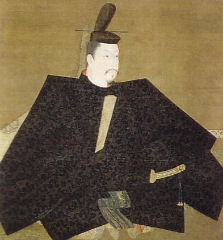 |
|
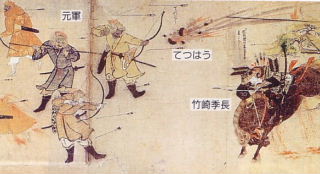 |
|
|
The first samurai shogun, Minamotono Yoritomo, established the Kamakura Bakufu in 1192. |
The Mongolian fleet attacked Kyushu twice (1274 and 1281). Samurais' fighting method (right) was not very effective against the Mongolians' superior weapons (left). However, Mongolian ships were sunk by a storm both times. |
The Edo government was politically conservative and highly bureaucratic. It imposed rigid social order and banned foreign contact and private trade (with a few exceptions). The small volume of foreign trade was the monopoly of the Edo government. Peace was restored under a strict bureaucratic rule. During this period of international isolation (more than two centuries: 1639-1854), agricultural productivity gradually rose, commercial agriculture and domestic trade grew, and Japan's unique culture developed. Conditions for industrialization were prepared.
The Westerners wanted to open up Japan from its self-imposed isolation. First, Russians came. Then other Europeans came. But the Edo government refused to deal with them. Finally, Americans (Commodore Perry and his troops) came with four "black ships" (steamers) loaded with powerful cannons to force Japan into concession (1853-54). The Edo government (and entire Japan) was thrown into confusion. In the middle of heated debate, the government suppressed the opposition and decided to open its ports. Criticism against the government rose sharply and internal political fights ensued, finally toppling the Edo government in 1967.
The new Meiji government upheld the emperor (who for a long time had no real power) as a national symbol and adopted the policy of rapid Westenization, modernization and militarization. Politically, the first constitution was drafted and parliamentary politics was established (1889-90). Economically, absorption of Western technology and creation of domestic industries were the primary national goal. The textile industry gradually became competitive, and Japan underwent Joint Stock Company Booms and the Industrial Revolution around the 1890s. Militarily, Japan won a war against China (Qing Dynasty) in 1894-95 and invaded Korea (colonized in 1910). Japan also fought with the Russian Empire in 1904-05 and won.
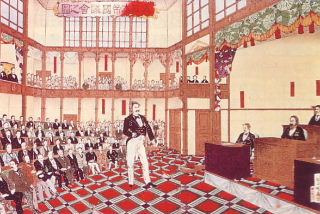 |
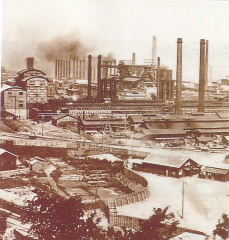 |
| The first imperial parliament opened in 1890 as a key step toward political modernization. At the first session, elected representatives demanded tax cuts while the government insisted on fiscal expansion. | The state-owned Yahata Steel Mill (Kita Kyushu City) was completed in 1901 using German technology with Japanese adjustments. |
The Japanese economy experienced an enormous export-led boom during WW1. During the 1920s, industrialization continued despite recessions, the Great Kanto Earthquake, and banking crises. The party cabinet system and the diplomacy of international cooperation (especially with the US) were implemented during most of the 1920s. But in the 1930s Japan faced the rise of fascism and militarism. Northeast China was occupied (Manchurian Incident, 1931), a full-scale war with China was initiated in 1937 and the Pacific War began in 1941. Wartime economic planning was adopted.
Japan was defeated in 1945 and the country's economic base was destroyed. Under the US occupation, a recovery strategy based on material planning was successfully conducted in 1947-48 and postwar inflation was terminated in 1949. From the mid 1950s through the early 1970s, Japan experienced very rapid growth and further industrialization. The manufacturing sector expanded strongly and Japan became the No.2 economy in the capitalist world (after the US) by the end of the 1960s. US military protection, global trade expansion, and a stable exchange rate contributed to the miracle growth.
After that, the Japanese economy matured and slowed down. In the 1970s, oil shocks and floating exchange rates reduced Japan's growth. An asset bubble in land and stocks occurred in the late 1980s, which bursted in 1990-91. Since the early 1990s and even to date, the Japanese economy has virtually stopped growing.
The Japanese calendar and the emperorFrom the Meiji period onward, when a new emperor comes to rule, Japan changes its national calendar. The name of the new emperor's reign is announced by the government by combining two Chinese characters with propitious meanings. For example,
The year 2011 is the 23rd year of Heisei. Some people write it as "H23". Most Japanese people (including myself) are more comfortable with the Western calendar, but official documents in Japanese language must often use the Japanese calendar year (only the year is different; month and day are the same in both). You can add 12 to the Western calendar year to arrive at the Japanese one. For example, 2011+12=2023=>H23 (ignore 2000). Article 1 of the current Japanese constitution (1946) states that "The Emperor shall be the symbol of the State and of the unity of the people, deriving his position from the will of the people with whom resides sovereign power." After the war, the emperor performs ceremonial roles only; he has no political power. Since Meiji, it is customary that an emperor remains in throne until he passes away (no "retirement" while alive). When he dies, his name is changed to the same name as his reign (for example, Emperor Meiji was called Mutsuhito while alive). The current emperor is Akihito, and will be called Emperor Heisei in the future. The emperor has no family name. The Imperial Household Law stipulates that the emperor must be male (I don't know why). But the crown prince and princess Masako have only one daughter. It may become necessary, in not-so-distant future, to change this law. Before Meiji, there could be more than one Japanese calendar per emperor, and he (or she) could often retire while alive. There were some female empresses in the distant past. |
<References>
Ito, Takatoshi, The Japanese Economy, MIT Press, 1992.
Kawakatsu, Heita, Nihon Bunmei to Kindai Seiyo: Sakoku Saiko (Japanese Civilization and Modern West: Rethinking the Closed Door Policy), NHK Books, 1991.
Maegawa, Keiji, "The Continuity of Cultures and Civilization: An Introduction to the Concept of Translative Adaptation," chapter 9, K. Ohno and I. Ohno, eds, Japanese Views on Economic Development: Diverse Paths to the Market, Routledge, 1998.
Maegawa, Keiji, Glocalization no Jinruigaku: Kokusai Bunka, Kaihatsu, Imin (The Anthropology of Glocalization: International Cultures, Development, Immigration), Shinyosha, 2004.
Minami, Ryoshin, The Economic Development of Japan, Macmillan, 1986.
Ohno, Kenichi, East Asian Growth and Japanese Aid Strategy, GRIPS 2003 (this book is available free of charge from GRIPS Development Forum. Especially see chapter 1, "Latecomer Countries and the Global Market Economy: the Risk of Premature International Integration Disrupting the Development Process."
Umesao, Tadao, Nihon towa Nanika: Kindai Nihon Bunmei no Keisei to Hatten (What is Japan?: Formation and Development of Modern Japanese Civilization), NHK Books, 1986.
Umesao, Tadao, An Ecological View of History: Japanese Civilization in the World Context, Trans Pacific Press, 2002.